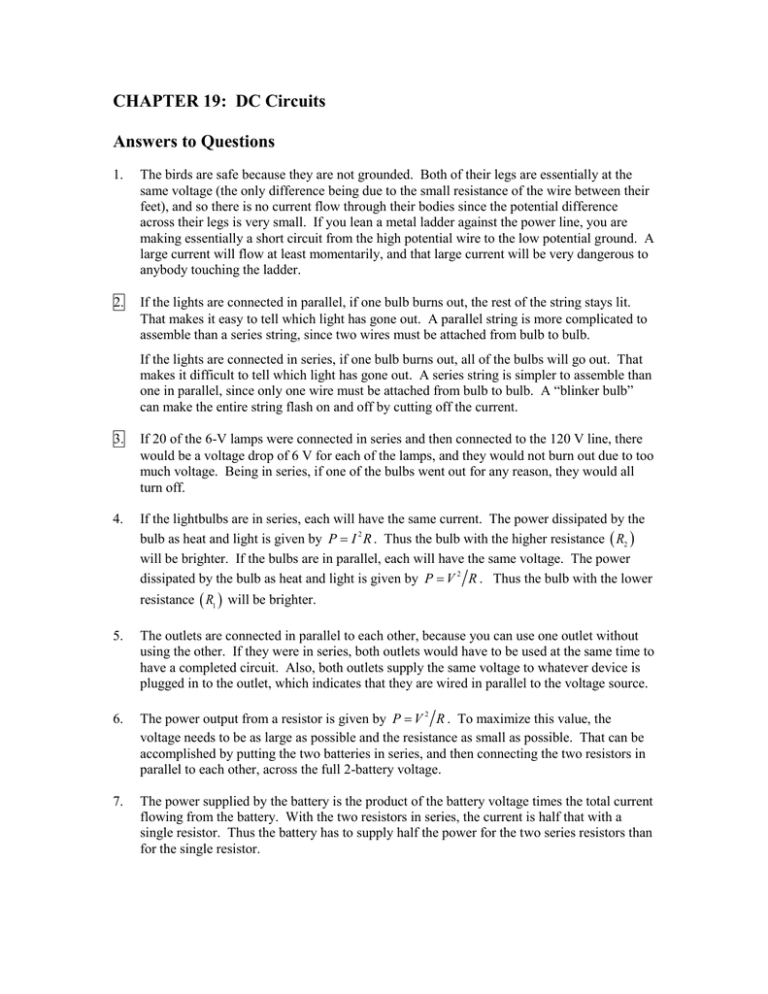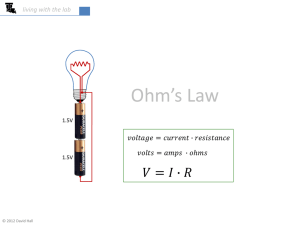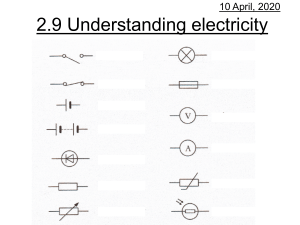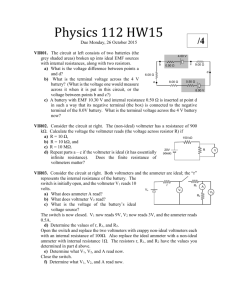CHAPTER 19: DC Circuits Answers to Questions
advertisement

CHAPTER 19: DC Circuits Answers to Questions 1. The birds are safe because they are not grounded. Both of their legs are essentially at the same voltage (the only difference being due to the small resistance of the wire between their feet), and so there is no current flow through their bodies since the potential difference across their legs is very small. If you lean a metal ladder against the power line, you are making essentially a short circuit from the high potential wire to the low potential ground. A large current will flow at least momentarily, and that large current will be very dangerous to anybody touching the ladder. 2. If the lights are connected in parallel, if one bulb burns out, the rest of the string stays lit. That makes it easy to tell which light has gone out. A parallel string is more complicated to assemble than a series string, since two wires must be attached from bulb to bulb. If the lights are connected in series, if one bulb burns out, all of the bulbs will go out. That makes it difficult to tell which light has gone out. A series string is simpler to assemble than one in parallel, since only one wire must be attached from bulb to bulb. A “blinker bulb” can make the entire string flash on and off by cutting off the current. 3. If 20 of the 6-V lamps were connected in series and then connected to the 120 V line, there would be a voltage drop of 6 V for each of the lamps, and they would not burn out due to too much voltage. Being in series, if one of the bulbs went out for any reason, they would all turn off. 4. If the lightbulbs are in series, each will have the same current. The power dissipated by the bulb as heat and light is given by P I 2 R . Thus the bulb with the higher resistance R2 will be brighter. If the bulbs are in parallel, each will have the same voltage. The power dissipated by the bulb as heat and light is given by P V 2 R . Thus the bulb with the lower resistance R1 will be brighter. 5. The outlets are connected in parallel to each other, because you can use one outlet without using the other. If they were in series, both outlets would have to be used at the same time to have a completed circuit. Also, both outlets supply the same voltage to whatever device is plugged in to the outlet, which indicates that they are wired in parallel to the voltage source. 6. The power output from a resistor is given by P V 2 R . To maximize this value, the voltage needs to be as large as possible and the resistance as small as possible. That can be accomplished by putting the two batteries in series, and then connecting the two resistors in parallel to each other, across the full 2-battery voltage. 7. The power supplied by the battery is the product of the battery voltage times the total current flowing from the battery. With the two resistors in series, the current is half that with a single resistor. Thus the battery has to supply half the power for the two series resistors than for the single resistor. 8. There is more current flowing in the room’s wiring when both bulbs are on, yet the voltage remains the same. Thus the resistance of the room’s circuit must have decreased. Also, since the bulbs are in parallel, adding two resistors in parallel always results in a net resistance that is smaller than either of the individual resistances. 9. No, the sign of the battery’s emf does not depend on the direction of the current through the battery. The sign of the battery’s emf depends on the direction you go through the battery in applying the loop rule. If you go from negative pole to positive pole, the emf is added. If you go from positive pole to negative pole, the emf is subtracted. But the terminal voltage does depend on the direction of the current through the battery. If current is flowing through the battery in the normal orientation (leaving the positive terminal, flowing through the circuit, and arriving at the negative terminal) then there is a voltage drop across the internal resistance, and the terminal voltage is less than the emf. If the current flows in the opposite sense (as in charging the battery), then there is a voltage rise across the terminal resistance, and the terminal voltage is higher than the emf. 10. (a) stays the same (b) increases (c) decreases (d) increases (e) increases (f) decreases (g) decreases (h) increases (i) stays the same 11. Batteries are connected in series to increase the voltage available to a device. For instance, if there are two 1.5-V batteries in series in a flashlight, the potential across the bulb will be 3.0 V. The batteries need not be nearly identical. Batteries are connected in parallel to increase the total amount of current available to a device. The batteries need to be nearly identical. If they are not, the larger voltage batteries will recharge the smaller voltage batteries. 12. The terminal voltage of a battery can exceed its emf if the battery is being charged – if current is passing through the battery “backwards” from positive pole to negative pole. Then the terminal voltage is the emf of the battery plus the voltage drop across the internal resistance. 13. Refer to Figure 19-2. Connect the battery to a known resistance R, and measure the terminal V voltage Vab . The current in the circuit is given by Ohm’s law to be I ab . It is also true R E Vab E Vab R that Vab E Ir and so the internal resistance can be calculated by r . I Vab 14. The formulas are “opposite” each other in a certain sense. When connected in series, resistors add linearly but capacitors add reciprocally, according to the following rules. Req R1 R2 R3 series 1 Ceq 1 C1 1 C2 1 C3 series The series resistance is always larger than any one component resistance, and the series capacitance is always smaller than any one component capacitance. When connected in parallel, resistors add reciprocally but capacitors add linearly, according to the following rules. 1 1 1 1 Ceq C1 C2 C3 Req R1 R2 R3 parallel parallel The parallel resistance is always smaller than any one component resistance, and the parallel capacitance is always larger than any one component capacitance. One way to consider the source of this difference is that the voltage across a resistor is proportional to the resistance, by V IR , but the voltage across a capacitor is inversely proportion to the capacitance, by V Q C . 15. The energy stored in a capacitor network can be calculated by PE 12 CV 2 . Since the voltage for the capacitor network is the same in this problem for both configurations, the configuration with the highest equivalent capacitance will store the most energy. The parallel combination has the highest equivalent capacitance, and so stores the most energy. Another way to consider this is that the total stored energy is the sum of the quantity PE 12 CV 2 for each capacitor. Each capacitor has the same capacitance, but in the parallel circuit, each capacitor has a larger voltage than in the series circuit. Thus the parallel circuit stores more energy. 16. The soles of your shoes are made of a material which has a relatively high resistance, and there is relatively high resistance flooring material between your shoes and the literal ground (the Earth). With that high resistance, a malfunctioning appliance would not be able to cause a large current flow through your body. The resistance of bare feet is much less than that of shoes, and the feet are in direct contact with the ground, so the total resistance is much lower and so a larger current would flow through your body. 17. As the sound wave is incident on the diaphragm, the diaphragm will oscillate with the same frequency as the sound wave. That oscillation will change the gap between the capacitor plates, causing the capacitance to change. As the capacitance changes, the charge state of the capacitor will change. For instance, if the plates move together, the capacitance will increase, and charge will flow to the capacitor. If the plates move apart, the capacitance will decrease, and charge will flow away from the capacitor. This current will change the output voltage. Thus if the wave has a frequency of 200 Hz, the capacitance and thus the current and thus the output voltage will all change with a frequency of 200 Hz. 18. The following is one way to accomplish the desired task. Light In the current configuration, the light would be on. If either switch is moved, the light will go out. But then if either switch were moved again, the light would come back on. 19. The total energy supplied by the battery is greater than the total energy stored by the capacitor. The extra energy was dissipated in the form of heat in the resistor while current was flowing. That energy will not be “recovered” during the discharging process. 20. An analog voltmeter has a high value resistor in series with the galvanometer, so that the actual voltage drop across the galvanometer is small. An analog ammeter has a very low value resistor in parallel with the galvanometer, so that the actual current through the galvanometer is small. Another significant difference is how they are connected to a circuit. A voltmeter goes in parallel with the component being measured, while an ammeter goes in series with the component being measured. 21. If you mistakenly use an ammeter where you intend to use a voltmeter, you are inserting a short in parallel with some resistance. That means that the resistance of the entire circuit has been lowered, and all of the current will flow through the low-resistance ammeter. Ammeters usually have a fairly small current limit, and so the ammeter might very likely get damaged in such a scenario. Also, if the ammeter is inserted across a voltage source, the source will provide a large current, and again the meter will almost certainly be damaged, or at least disabled by burning out a fuse. 22. An ideal ammeter would have zero resistance so that there was no voltage drop across it, and so it would not affect a circuit into which it was placed in parallel. A zero resistance will not change the resistance of a circuit if placed in series, and hence would not change the current in the circuit. An ideal voltmeter would have infinite resistance so that it would draw no current, and thus would not affect a circuit into which it was placed in parallel. An infinite resistance will not change the resistance of a circuit if placed in parallel, and hence would not change the current in the circuit. 23. The behavior of the circuit is the same in either case. The same current will flow in the circuit with the elements rearranged, because the current in a series circuit is the same for all elements in the circuit. 24. When the voltmeter is connected to the circuit, it reduces the resistance of that part of the circuit. That will make the (resistor + voltmeter) combination a smaller fraction of the total resistance of the circuit than the resistor was alone, which means that it will have a smaller fraction of the total voltage drop across it. 25. The voltmeter, if it has a particularly high internal resistance, will measure the emf of the battery, which is 1.5 V. But if the battery has a high internal resistance (indicating that the battery is “used up”, then its terminal voltage, which is the voltage supplied to the flashlight bulb, can be quite low when more current is drawn from the battery by a low resistance like the bulb.





